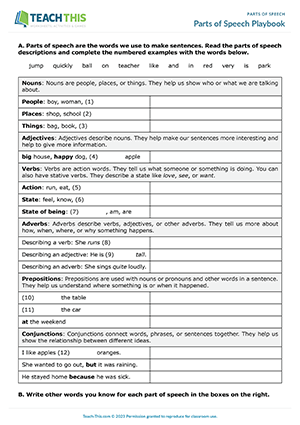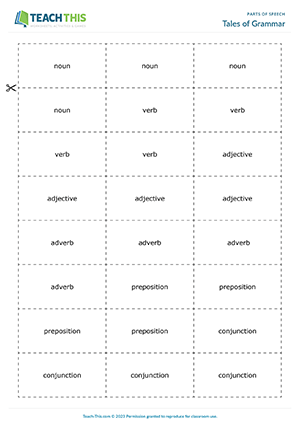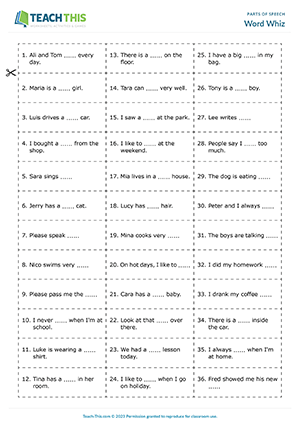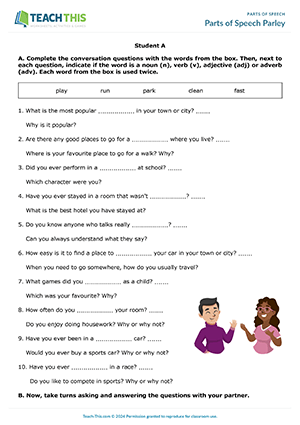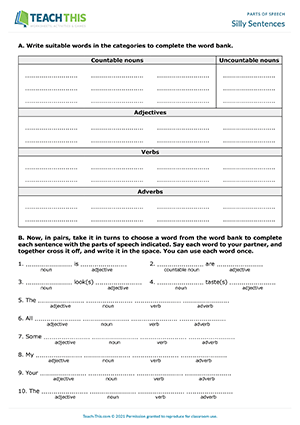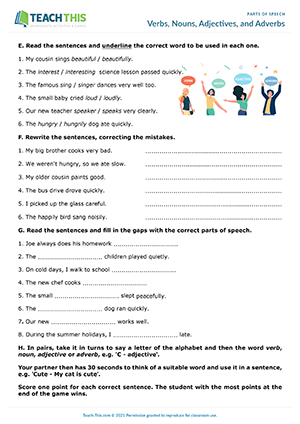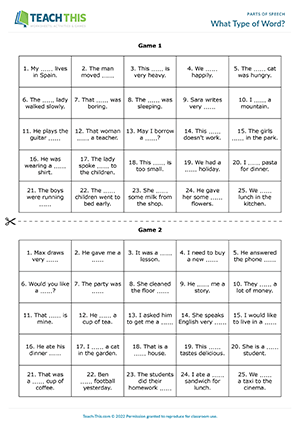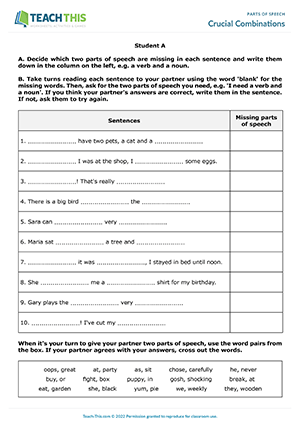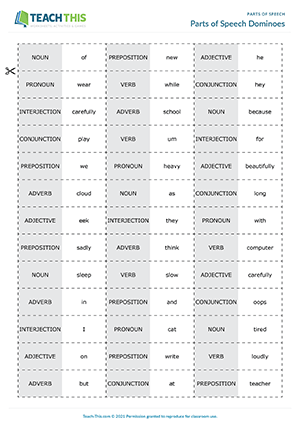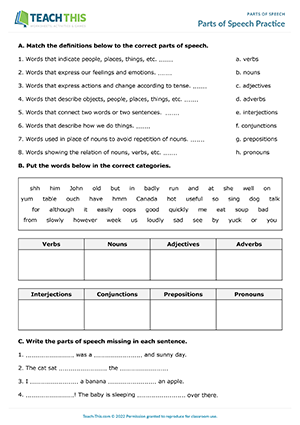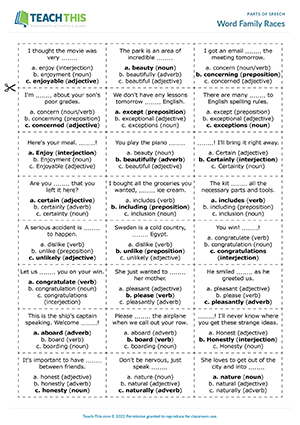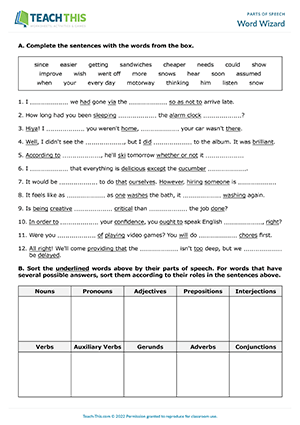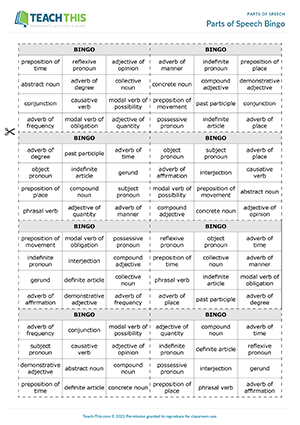Here is an informative parts of speech worksheet to help introduce students to nouns, verbs, adjectives, adverbs, prepositions, and conjunctions. First, students read parts of speech descriptions and complete numbered examples with the words provided. Students then write other words they know for each part of speech. Next, students label the word in bold in each sentence according to its part of speech. Finally, students test their knowledge of parts of speech by completing sentences using parts of speech given in brackets.
In this imaginative parts of speech activity, students match words with parts of speech and then use the words in a collaborative short story. To begin, in groups, students play a matching game where they take turns to pick up a parts of speech card and match it with a corresponding word card. When the groups have matched all the cards, they create a story using the word cards. Students choose one word card for each part of speech, e.g. snake, sit, hungry, really, on, so. Working in their groups, students then create a short story containing all six words from their word cards. Finally, groups read their stories to the class, who vote for the best one.
Here is an entertaining parts of speech game to help students practice verbs, nouns, adjectives and adverbs. In the game, students race to identify the missing part of speech in a sentence and complete the sentence with a suitable word. Players take turns picking up a card, reading out the sentence using the word BLANK for the missing word and then placing the card face-up on the table, e.g. 'Ali and Tom BLANK every day.' All the players then race to put a card with the correct part of speech down next to the sentence (e.g. a verb card), saying a suitable word to complete the sentence at the same time, e.g. study. If the part of speech is correct and the word matches the sentence, the player leaves their card on the table. If a player places an incorrect part of speech card down or fails to come up with a suitable word, they take back their part of speech card, and other players can try to answer. The first player to get rid of all their cards wins the game.
In this insightful parts of speech speaking activity, students review their knowledge of the basic parts of speech while completing, asking and answering conversation questions. First, in two groups, students complete each conversation question with a suitable word from a box and then indicate whether the word is a noun, verb, adjective or adverb. Next, students pair up with someone from the other group and take turns asking the conversation questions to their partner, who responds accordingly. Afterwards, students share what they found out about their partner with the class.
This creative parts of speech activity helps students learn and practice how to use nouns, verbs, adjectives and adverbs in sentences. First, brainstorm nouns, verbs, adjectives and adverbs as a class. Students then copy down the words into the word bank on their worksheet. In pairs, students then take it in turns to choose a word from the word bank to complete each sentence with the parts of speech indicated. Students say each word to their partner, and both students cross it off in the word bank and write it in the space provided. Each word can only be used once. When the students have finished, review the sentences they came up with together as a class.
This free parts of speech worksheet helps students learn how to identify verbs, nouns, adjectives, and adverbs and use them in sentences. First, students read a sentence and put the words in the correct parts of speech category. Students then read sentences describing verbs, nouns, adjectives and adverbs and indicate which part of speech is being described in each one. Next, students put words into the correct parts of speech category and put words in the correct order to make sentences. Students then move on to read sentences and underline the correct part of speech to be used in each one. Afterwards, students rewrite sentences, correcting the mistakes. Next, students read sentences and fill in gaps with the correct parts of speech using their own ideas. Lastly, in pairs, students take it in turns to say a letter of the alphabet and then the word verb, noun, adjective or adverb. Their partner then has 30 seconds to think of a suitable word and use it in a sentence. Students score one point for each correct sentence. The student with the most points at the end of the game wins.
Here is a useful parts of speech game to help students identify the position of verbs, nouns, adjectives and adverbs in sentences. In groups of three, two students play the first game and one student acts as judge. The players take it in turns to choose a square and identify the missing part of speech in the sentence. The student acting as judge checks the answer sheet. If the part of speech is correct, the player chooses a suitable word to complete the sentence. If the judge agrees the word is appropriate, the player marks the square with an 'O' or an 'X' accordingly. It is then the other player's turn to choose a square. The first player to get five squares in a row wins the game. Afterwards, students play a second game, giving the student who acted as judge a chance to play.
In this fun parts of speech game, students race to guess missing parts of speech in sentences. First, in two groups, students identify the two missing parts of speech in each sentence on their worksheet, writing down their answers. Next, students pair up with someone from the other group. Students then take turns reading each sentence to their partner using the word 'blank' for the missing words and then asking for the two parts of speech they need to complete the sentence, e.g. 'I need a verb and a noun'. Their partner checks the word pairs in the box on their worksheet for the appropriate words and reads them aloud. If the student agrees the answers are correct, they write the words in the sentence and their partner crosses them out. When a pair has completed all their sentences, they put up their hands to have their answers checked. The first pair to complete all their sentences correctly wins.
In this productive parts of speech game, students match words with parts of speech and make sentences using the words. The first player places one of their dominoes at either end of the domino on the table, matching a word with a part of speech or vice versa. The player then makes a sentence using the word they just matched with the part of speech. For example, if a student matched the word of with preposition, they might say 'Windows are made of glass'. The other group members listen and judge the sentence. If the other students agree the sentence is correct and uses the part of speech appropriately, the domino remains in place. If not, the player must take back the domino. Play then passes to the next student and so on. The first player to get rid of all their dominoes wins the game.
Here is a free parts of speech worksheet to help students learn and practice the eight parts of speech. Students start by matching definitions to the correct parts of speech. Next, students put words into their parts of speech categories. Students then decide which parts of speech are missing from sentences. After that, students complete sentences with words from Exercise B. Following that, students identify and underline the word that does not belong in each word group. Lastly, students complete sentences with their own words.
In this engaging parts of speech game, students identify which of several related words is the correct part of speech to complete sentences. In groups, students take turns picking up a card and reading out the sentence on the card using the word 'blank' for the missing word in the sentence, e.g. I thought the movie was very 'blank'. Next, the student reads out three words from a word family, e.g. enjoy, enjoyment, enjoyable. The other group members listen and race to choose the correct word to complete the sentence, along with correctly identifying the word's part of speech. The first student to say the correct word and part of speech wins and keeps the card. Students get one guess per round. If no one gets the correct word and part of speech, the card is placed at the bottom of the pile to be used again later in the game. The student with the most cards at the end of the game wins.
In this comprehensive parts of speech worksheet, students identify parts of speech and use them to construct grammatically correct sentences. Students start by completing sentences with words from a box. Next, students sort the underlined words in the sentences by their parts of speech. After that, students identify parts of speech errors in sentences and rewrite them so that they are correct. Finally, students use their knowledge of parts of speech to unscramble sentences.
In this enjoyable parts of speech game, students play bingo by matching advanced parts of speech with words. You or a student reads a word at random from the caller's sheet. There are four words to choose from for each part of speech. Students look at their bingo cards to see if they can match the word with a part of speech shown on their card. If they can, they cross off the part of speech. The game continues until a student has crossed off all the parts of speech on their card. When this happens, the student shouts 'Bingo!' and reads out the parts of speech they crossed off. If they match with the words that were called out, the student wins the game. Play several rounds, making sure students receive a different bingo card each time.
Latest Free
Resources
- Count on Me!
Making Offers and Promises (A2)
Date Added: 11th of February
- It’s Carnival Time!
Cultural Celebrations (B1)
Date Added: 29th of January
- Identifying and Clarifying Problems
Dealing with Problems (B2)
Date Added: 1st of November
- The Bus Stop
Getting Around (B1)
Date Added: 1st of October
- Study Skills Showdown
Study Skills (B2)
Date Added: 10th of September
Latest Member
Resources
- Reading Rotation Challenge
Reading Exam Preparation (B1)
Date Added: 3rd of March
- Who has asked the right question?
Present Perfect Wh Questions (B1)
Date Added: 26th of February
- Perfectly Played!
Present Perfect Wh Questions (B1)
Date Added: 25th of February
- Present Perfect Wh Question Time
Present Perfect Wh Questions (B1)
Date Added: 24th of February
- Express, Justify and Debate!
Speaking Test Preparation (B1)
Date Added: 20th of February



